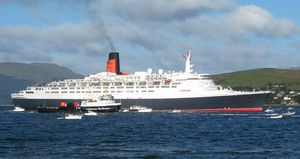Caledonian MacBrayne fleet
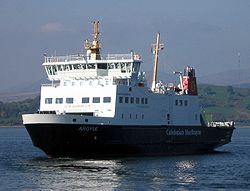
Caledonian MacBrayne (CalMac) operates the largest fleet of car and passenger ferries in the United Kingdom, with 30 units in operation. The company provides lifeline services to 22 islands off the west coast of Scotland, as well as operating on routes across the River Clyde.
Calmac vessels can be readily identified by their black hulls and white superstructures. They have red funnels with black caps that display the Lion Rampant badge with masts in buff. The fleet of Calmac can be categorised into various groups.
Contents
Groups of vessels
Major units
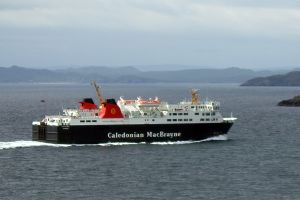
There are presently 8 vessels over 80 m length in the CalMac fleet: MV Isle of Arran, MV Hebridean Isles, MV Isle of Mull, MV Lord of the Isles, MV Caledonian Isles, MV Isle of Lewis, MV Clansman and MV Hebrides.
These vessels are usually found on the longer crossings which generate high passenger numbers. MV Isle of Lewis is the largest vessel in the fleet, at 101 m in length, and operates on the Ullapool - Stornoway, Lewis run. MV Caledonian Isles has the highest passenger capacity and can carry 1000 people on the Ardrossan - Brodick, Arran crossing.
Clyde service
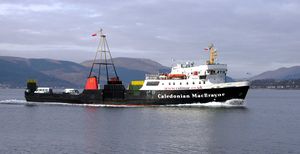
MV Jupiter, MV Juno and MV Saturn were given the nickname of the streakers in the fleet, because of their speed and ability to manoeuvre rapidly both at sea and in port. They faithfully served two routes for the best part of 30 years: Gourock - Dunoon, and Wemyss Bay - Rothesay on the Isle of Bute.
After three decades of service with Calmac, the streakers are now showing their age and are being replaced. In spring 2005, the company took delivery of MV Bute to serve the island of Bute from the Wemyss Bay pier-head. A second vessel, MV Argyle entered service in 2007. Removal of one of the streakers was delayed by pier work at Rothesay to allow full ro-ro operation. There was much controversy in Scotland following the decision to award the shipbuilding contracts for Bute and Argyle to yards outside in Poland.[1]
Since 2002 the passenger service between Gourock and Dunoon has been supplemented by MV Ali Cat, chartered by MacBrayne from Solent and Wightline Cruises.
Loch class
The Loch class are a type of ship, most of which are symmetrical when viewed from the side, and in any case have no operational bow or stern. They have a single car deck, running the length and breadth of the ship. Passenger accommodation is found down the sides of the ship (this can be on both sides or just one depending on the vessel), and also, in the case of MV Loch Portain, MV Loch Buie and MV Loch Shira, above the car deck.
They operate on shorter crossings; usually between 5 and 30 minutes; although MV Loch Portain takes 70 minutes to cross the Sound of Harris between Berneray and Leverburgh.
The Loch class vessels come in a variety of shapes and sizes, the largest and newest of which is the 54.27m by 13.90m MV Loch Shira, built for and currently running on the Largs to Cumbrae route. The previous largest vessels in the class - MV Loch Fyne and MV Loch Dunvegan - are a mere 7 centimetres shorter.
There are 10 other Loch class vessels, decreasing in size to 30.2 m.
Island class
By far the smallest vessels in Calmac's fleet at 22.5 m long, there remain only 2 of the original 8 ships, MV Eigg and MV Raasay. MV Canna is now operated by Rathlin Island Ferry Ltd.[2]
All were built by James Lamont & Co at Port Glasgow, between 1972 and 1976, as the predecessors to the Loch class. They were of a very simple design, based on World War II landing craft. They had a two-part folding bow ramp, leading to an open plan car deck incorporating a small turntable immediately aft and a sheltered area of passenger accommodation at the stern. The wheelhouse was above the passenger accommodation and the main mast above the ramp at the bow. A radar mast sat on top of the bridge, just forward of the small funnel and engine exhaust.[3] They can carry 164 passengers and 6 cars.
Other vessels
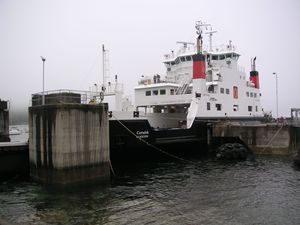
There are three vessels in the fleet which cannot be listed in the above categories.
- MV Coruisk
MV Coruisk is a 65 m 'sheltered water vessel', operating on the Mallaig-Armadale, Isle of Skye route in summer, and on the Clyde in winter. She appears rather tall for her length, and is very distinctive with her incredible jumble of passenger accommodation above the car deck - which is fitted out to standards as high as any other vessel in the fleet. She looks similar to the 'Loch Class' vessels, but has a recognisable bow and stern (this designation is only an operational one when sea conditions necessitate the use of the vessel's stabilising fins, otherwise adequate progress for crossings can be made in "reverse").[citation needed]
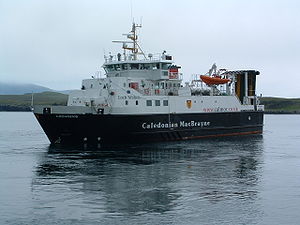
- MV Lochnevis
MV Lochnevis is a highly specialised ship serving the Small Isles of Eigg, Canna, Rùm and Muck from Mallaig. She is 49.2 m , and has capacity for 190 passengers. Her vehicle deck can accommodate up to 14 cars, but is empty on most sailings due to the lack of roads and vehicle restrictions on the Small Isles. It is instead used mostly for goods and vital equipment for the islands. Lochnevis has a surprisingly large vehicle ramp, which dominates her appearance.[citation needed] This is to allow her to berth a considerable distance from linkspans so as to protect her exposed Azipod propulsion systems in shallow waters.
- MV Muirneag
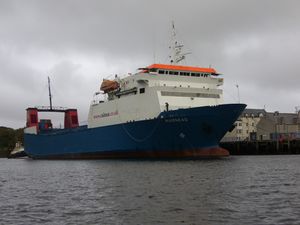
In addition to these passenger vessels, Calmac operates MV Muirneag, a dedicated freight ferry, plying between Ullapool and Stornoway, on an overnight basis. She is theoretically the largest vessel in the fleet at 105 m long, but because she is chartered she is not officially a Calmac vessel. As a result, she does not wear the full Calmac colours, but retains a blue hull, with Calmac branding and funnels. Sailing overnight across the Minch, Muirneag has to withstand extremely poor sea conditions. On 11 November 2005, she spent 16 hours attempting to gain access to Stornoway Harbour in a heavy storm.[citation needed]
Fleet statistics
| Name | Cars | Type | Built |
|---|---|---|---|
| MV Jupiter | 40 | Car ferry | 1974 |
| MV Eigg | 6 | Car ferry | 1975 |
| MV Raasay | 6 | Car ferry | 1976 |
| MV Isle of Cumbrae | 18 | Car ferry | 1977 |
| MV Saturn | 40 | Car ferry | 1977 |
| MV Isle of Arran | 80 | Car ferry | 1983 |
| MV Hebridean Isles | 68 | Car ferry | 1985 |
| MV Loch Striven | 12 | Car ferry | 1986 |
| MV Loch Linnhe | 12 | Car ferry | 1986 |
| MV Loch Riddon | 12 | Car ferry | 1986 |
| MV Loch Ranza | 12 | Car ferry | 1987 |
| MV Isle of Mull | 80 | Car ferry | 1987 |
| MV Lord of the Isles | 56 | Car ferry | 1989 |
| MV Loch Dunvegan II | 36 | Car ferry | 1991 |
| MV Loch Fyne | 36 | Car ferry | 1991 |
| MV Loch Buie | 10 | Car ferry | 1992 |
| MV Loch Tarbert | 18 | Car ferry | 1992 |
| MV Caledonian Isles | 110 | Car ferry | 1993 |
| MV Isle of Lewis | 123 | Car ferry | 1995 |
| MV Loch Bhrusda | 18 | Car ferry | 1996 |
| MV Loch Alainn | 24 | Car ferry | 1997 |
| MV Clansman V | 90 | Car ferry | 1998 |
| MV Lochnevis II | 14 | Car ferry | 2000 |
| MV Hebrides III | 110 | Car ferry | 2000 |
| MV Ali Cat | 0 | Passenger Catamaran | 2000 (chartered 2002) |
| MV Muirneag | 0 | Freight ferry | 1979 (chartered 2002) |
| MV Loch Portain | 32 | Car ferry | 2003 |
| MV Coruisk III | 40 | Car ferry | 2003 |
| MV Bute VII | 60 | Car ferry | 2005 |
| MV Argyle VII | 60 | Car ferry | 2006 |
| MV Loch Shira | 24 | Car ferry | 2006 |
References
- ↑ "History of MV Bute". Ships of Calmac.co.uk. http://www.shipsofcalmac.co.uk/h_bute1.asp. Retrieved 2007-08-27.
- ↑ "Press Release: A Warm Welcome for New Rathlin Operator" (PDF). Rathlin Island Ferry Ltd. 28 April 2008. http://rathlinballycastleferry.com/PressReleaseApril28th.pdf. Retrieved 20 September 2009.
- ↑ "Island Class Vessels". Ships of Calmac. http://www.shipsofcalmac.co.uk/ff_island_class.asp. Retrieved 2009-08-02.
External links
| Caledonian MacBrayne
]]